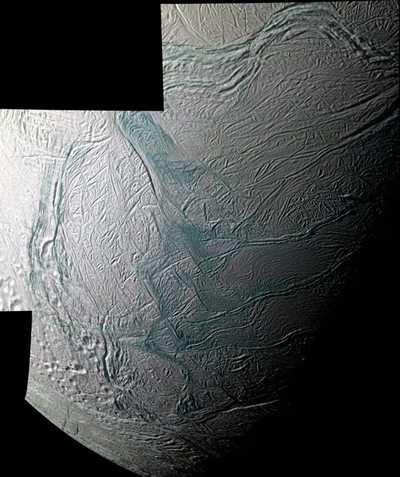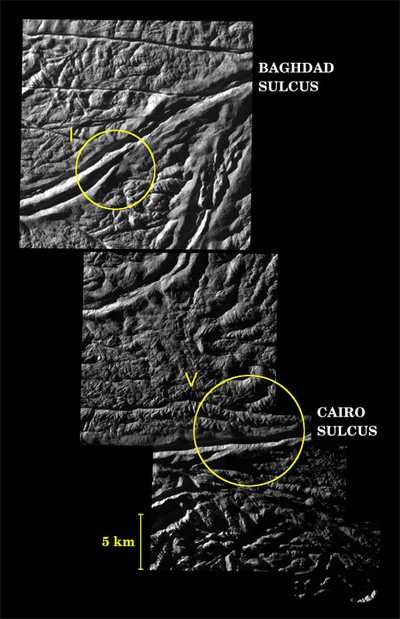Photos Reveal "Tiger Stripe" Fissures On Moon's Surface
In a feat of interplanetary sharpshooting, NASA's Cassini
spacecraft has pinpointed precisely where the icy jets erupt from
the surface of Saturn's geologically active moon Enceladus.

New carefully targeted pictures reveal exquisite details in the
prominent south polar "tiger stripe" fractures from which the jets
emanate. The images show the fractures are about 300 meters (980
feet) deep, with V-shaped inner walls. The outer flanks of some of
the fractures show extensive deposits of fine material. Finely
fractured terrain littered with blocks of ice tens of meters in
size and larger (the size of small houses) surround the
fractures.
"This is the mother lode for us," said Carolyn Porco, Cassini
imaging team leader at the Space Science Institute, Boulder, CO. "A
place that may ultimately reveal just exactly what kind of
environment -- habitable or not -- we have within this tortured
little moon."
One highly anticipated result of this flyby was finding the
location within the fractures from which the jets blast icy
particles, water vapor and trace organics into space. Scientists
are now studying the nature and intensity of this process on
Enceladus, and its effects on surrounding terrain. This
information, coupled with observations by Cassini's other
instruments, may answer the question of whether reservoirs of
liquid water exist beneath the surface.
The high-resolution images were acquired during an August 11,
2008, flyby of Enceladus, as Cassini sped past the icy moon at
64,000 kilometers per hour (40,000 miles per hour). A special
technique, dubbed "skeet shooting" by the imaging team, was
developed to cancel out the high speed of the moon relative to
Cassini and obtain the ultra-sharp views.

"Knowing exactly where to point, at just the right time, was
critical to this event," said Paul Helfenstein, Cassini imaging
team associate at Cornell University, Ithaca, NY, who developed and
used the skeet-shoot technique to design the image sequence. "The
challenge is equivalent to trying to capture a sharp, unsmeared
picture of a distant roadside billboard with a telephoto lens out
the window of a speeding car."
Helfenstein said that from Cassini's point of view, "Enceladus
was streaking across the sky so quickly that the spacecraft had no
hope of tracking any feature on its surface. Our best option was to
point the spacecraft far ahead of Enceladus, spin the spacecraft
and camera as fast as possible in the direction of Enceladus'
predicted path, and let Enceladus overtake us at a time when we
could match its motion across the sky, snapping images along the
way."
For scientists, having the combination of high-resolution
snapshots and broader images showing the whole region is critical
for understanding what may be powering the activity on
Enceladus.
"There appears to have been extensive fallout of icy particles
to the ground, along some of the fractures, even in areas that lie
between two jet source locations, though any immediate effects of
presently active jets are subtle," Imaging scientists suggest that
once warm vapor rises from underground to the cold surface through
narrow channels, the icy particles may condense and seal off an
active vent. New jets may then appear elsewhere along the same
fracture.

"For the first time, we are beginning to understand how freshly
erupted surface deposits differ from older deposits," said
Helfenstein, an icy moons expert. "Over geologic time, the
eruptions have clearly moved up and down the lengths of the tiger
stripes."
 ANN's Daily Aero-Linx (04.15.24)
ANN's Daily Aero-Linx (04.15.24) Classic Aero-TV: 'No Other Options' -- The Israeli Air Force's Danny Shapira
Classic Aero-TV: 'No Other Options' -- The Israeli Air Force's Danny Shapira Aero-News: Quote of the Day (04.15.24)
Aero-News: Quote of the Day (04.15.24) Airborne 04.16.24: RV Update, Affordable Flying Expo, Diamond Lil
Airborne 04.16.24: RV Update, Affordable Flying Expo, Diamond Lil ANN's Daily Aero-Term (04.16.24): Chart Supplement US
ANN's Daily Aero-Term (04.16.24): Chart Supplement US





